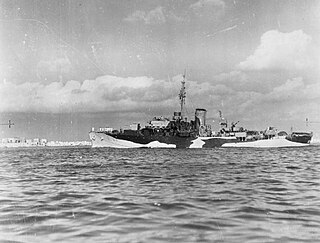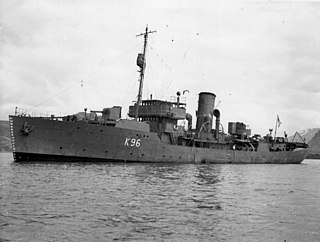HMS Gladiolus was a Flower-class corvette of the Royal Navy, the first ship of her class.

HMS Berkeley Castle was a Castle-class corvette of the United Kingdom's Royal Navy. Built and commissioned in 1943, she escorted convoys from 1944 to 1945. She later served as an air-sea rescue ship until being placed in reserve. Damaged beyond repair in the North Sea flood of 1953 while at a dry dock in Sheerness, she was scrapped a few years later. She was named after Berkeley Castle in Gloucestershire.

HMS Bryony was a Flower-class corvette that served in the Royal Navy and Royal Norwegian Navy.
HMS Marigold was a Flower-class corvette of the Royal Navy. She was launched on 4 September 1940 and was sunk by an Italian air-dropped torpedo on 9 December 1942.
When the United States entered World War II at the end of 1941, the United States Navy found itself deficient in ocean escort-type vessels. A crash building program was instituted; but, to meet more immediate needs, the government contracted with shipbuilding firms in England and Canada to build Flower-class corvettes. Vim (PG-99) was one of those British-type escorts. She was launched on 1 April 1943 at the Collingwood Shipyard in Collingwood, Ontario. Nine days later, however, she was transferred to the Royal Navy under the terms of the lend-lease agreement in return for another Flower-class corvette then under construction in Canada. The British renamed her HMS Statice, and she served the Royal Navy under the name through World War II. On 21 June 1946, she was returned to the United States Navy. Though carried on the Navy list as PG-99, the corvette never saw active service with the United States Navy. She was sold on 7 May 1947. To whom she was sold and to what purpose she was put is unknown.

HMS Vetch (K132) was a Flower-class corvette that served in the Royal Navy during the Second World War. After helping to escort many convoys and sinking two U-boats, she was decommissioned and sold in 1945.

HMS Oakham Castle was a Royal Navy corvette of the Castle class. Built as a convoy escort during the Second World War, it later became a weather ship before being scrapped in 1977.

HMS Rhododendron was a Flower-class corvette that served with the Royal Navy during the Second World War. She served as an ocean escort in the Battle of the Atlantic.

HMS Aubrietia (K96) was a Flower-class corvette built for the Royal Navy (RN) from 1941-1946. She was active as a convoy escort in the Atlantic and Mediterranean. In May 1941, Aubrietia sighted and depth charged the German submarine U-110, leading to its capture and the seizure of a German Naval Enigma and its Kurzsignale code book.

HMS Delphinium (K77) was a Flower-class corvette built for the Royal Navy (RN) from 1940-1946. From 1941 to 1943 she was active in the Mediterranean as an escort to convoys supporting the Eighth Army and the invasion of Sicily. From mid-1943 onwards she was on convoy escort duties between Africa, the Mediterranean and the United Kingdom; and Atlantic convoys between North America and the United Kingdom. She escorted a total of 68 convoys.
HMS Cuckmere (K299) was a River-class frigate of the Royal Navy (RN) in 1943. Cuckmere was originally to be built for the United States Navy, having been laid down as PG-104, but was transferred to the Royal Navy as part of Lend-Lease and finished to the RN's specifications as a Group II River-class frigate. She was first Royal Navy ship to carry the name Cuckmere.
HMS Erica was a Flower-class corvette that served in the Royal Navy and was built by Harland and Wolff in 1941. She was named after Erica. Commissioned in 1940 and sunk by a mine on 9 February 1943.

HMS Pink was a Flower-class corvette that served in the Royal Navy. She was built by Henry Robb in Leith in 1941 and named after the flower nicknamed garden pink. She was commissioned in 1942 and scrapped in 1947.
HMS Snapdragon was a Flower-class corvette that served in the Royal Navy and was built by Smith's Dock Company in 1940. She was named after Snapdragon. Commissioned in 1940 and sunk by Luftwaffe on 19 December 1942.
HMS Auricula was a Flower-class corvette that served in the Royal Navy and was built by George Brown and Company in 1940. She was named after Auricula. Commissioned in 1941 and sunk by a mine on 6 May 1942.

HMS Asphodel was a Flower-class corvette that served in the Royal Navy and was built by George Brown and Company in 1940. She was named after Asphodel. Commissioned in 1940 and sunk by U-575 on 10 March 1944.

HMS Gardenia was a Flower-class corvette that served in the Royal Navy and was built by William Simons and Company in 1940. She was named after Gardenia. Commissioned in 1940, rammed and sunk by HMS Fluellen on 9 November 1942.
HMS Fleur de Lys was a Flower-class corvette that served in the Royal Navy and was built by Smith's Dock Company in 1940. She was named after Fleur de Lys. Commissioned in 1940, rammed and sunk by U-206 on 14 October 1941. Her name was originally La Dieppoise and built for the French Navy but was later changed.

HMS Poppy was a Flower-class corvette that served in the Royal Navy as a convoy escort during World War II.

HMS Amaranthus (K17) was a Flower-class corvette of the Royal Navy. She took part in the Second World War, being involved in escorting convoys from West Africa to the United Kingdom from May 1941 onwards.











